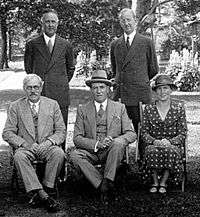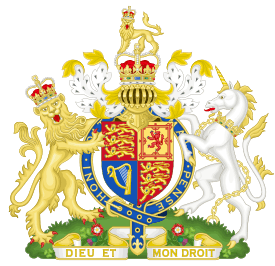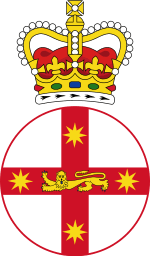David Murray Anderson
| Admiral Sir Murray Anderson KCB, KCMG, MVO, KStJ | |
|---|---|
 Anderson at Government House upon his arrival in Sydney. | |
| 28th Governor of New South Wales | |
|
In office 6 August 1936 – 30 October 1936 | |
| Monarch | Edward VIII |
| Lieutenant | Sir Philip Street |
| Preceded by | The Lord Gowrie |
| Succeeded by | The Lord Wakehurst |
| 66th Governor of Newfoundland | |
|
In office 20 October 1932 – 12 January 1936 | |
| Monarch | George V |
| Prime Minister | Frederick C. Alderdice |
| Preceded by | John Middleton |
| Succeeded by | Humphrey T. Walwyn |
| Personal details | |
| Born |
11 April 1874 Newton-by-Chester, Cheshire, England |
| Died |
30 October 1936 (aged 62) Sydney, Australia |
| Spouse(s) |
Dame Edith Muriel Anderson (née Teschemaker) |
| Military service | |
| Allegiance |
|
| Service/branch |
|
| Years of service | 1887–1932 |
| Rank | Admiral |
| Commands |
Africa Station (1926–29) China Station (1925) HMS Ajax (1918–19) HMS Hyacinth (1913–17) |
| Battles/wars | |
| Awards |
Knight Commander of the Order of the Bath Knight Commander of the Order of St Michael and St George Member of the Royal Victorian Order Knight of the Order of Saint John Mentioned in Despatches |
Admiral Sir David Murray Anderson KCB, KCMG, MVO, KStJ (11 April 1874 – 30 October 1936) was a British naval officer and governor. Anderson served in the Royal Navy from the age of 13 and served in many Colonial wars and was given various Empire postings, rising to the rank of Admiral in 1931. He retired a year later and took up the posting as Governor of Newfoundland, where he also took up the role of Chairman of the Government following the suspension of self-government in the Dominion of Newfoundland. Leaving Newfoundland in 1935, he was appointed as Governor of New South Wales but served only briefly due to his ill health. He died while in office aged 62.[1]
Early life and career
Anderson was born on 11 April 1874, the second son of General David Anderson, Colonel-in-Chief of the Cheshire Regiment, and his wife Charlotte Christina, née Anderson in Newton-by-Chester in Cheshire, England. His elder brother was Lieutenant General Sir Warren Hastings Anderson. In 1887, as a 13-year-old, he became a cadet at the Royal Naval College, Dartmouth. Seeing action against King Koko slave traders on the Niger River, he became a lieutenant on 23 February 1895 at age 20.[2] Anderson saw further action against West-African rebels and in the Ashanti Campaign. In May 1902, he was posted as First and gunnery lieutenant to the cruiser HMS Brilliant on the Channel Squadron.[3]
In 1905 he was promoted to commander and was posted to the Royal Yacht HMY Victoria and Albert in 1908. That year, he married a New Zealander, Edith Teschemaker. On 29 July 1910 Anderson was appointed a Member (Fourth Class) of the Royal Victorian Order.[4] On 11 August 1911, he was promoted to captain[5] and posted as Flag Captain on HMS Hyacinth from 1913 to 1917.[6]
When the First World War broke out he took part in the operations that resulted in the destruction of the SMS Königsberg in German East Africa, and was Mentioned in Despatches in 1915. For his actions leading to the capture of Dar es Salaam he was appointed a Commander of the Order of St Michael and St George (CMG) on 1 January 1918.[7] He was also invested by the Sultan of Zanzibar with the Order of the Brilliant Star of Zanzibar, Second Class.[8] From 1918 to 1919 Anderson was posted to command the battleship HMS Ajax in the Grand Fleet.[6] In May 1921 he was appointed as an aide-de-camp (ADC) to King George V, which he held until April 1922. After a posting in England, he was promoted to rear admiral in 1922. On 2 June 1923 he was appointed as a Companion of the Order of the Bath (CB).[9] He was later posted from August 1923 to October 1925 as the Senior Naval Officer, Yangtze and briefly served as temporary Commander-in-Chief China Station in 1925. While in China, he was called upon on three separate occasions to command a multi-national force of Japanese, British, American, Portuguese and Italian sailors to help protect the Shanghai International Settlement. For his efforts in China, he was awarded the Order of the Rising Sun, Third Class, by the Emperor Hirohito of Japan.[8]
Further promoted to vice admiral in 1927, he was appointed to command the Africa Station. From June to September 1928 he served as High Commissioner to the Union of South Africa. Being fluent in French, he was further appointed to Geneva as the Admiralty representative to the League of Nations permanent advisory commission from 1929 to 1931. On 3 June 1930 he was appointed as a Knight Commander of the Order of the Bath (KCB),[10] and was promoted to admiral in 1931. He retired at his own request on 5 July 1932.[11]
Governor of Newfoundland

Anderson was then appointed on 20 October 1932 as the Governor of Newfoundland.[12] He became His Majesty's Representative at a time of great instability in the Dominion of Newfoundland. Newfoundland had been hit badly by the Great Depression, leaving most of the banks on the verge of bankruptcy, saved only by emergency loans from Britain, the state Treasury was empty and the political process was discredited by corruption and incompetence.[13]
The Government, led by Prime Minister Frederick C. Alderdice, called upon the British government to take direct control until Newfoundland could become self-sustaining. The United Kingdom, concerned over Newfoundland's likelihood of defaulting on its loans, asked the government to establish the Newfoundland Royal Commission, headed by a Scottish peer, Lord Amulree. Its report, released in 1933, assessed Newfoundland's political system as institutionally corrupt and its economic future as bleak, recommending the abolition of responsible government, and its replacement by a Commission of the British Government.[1] Acting on the report's recommendations, Alderdice's government voted itself out of existence in December 1933. Appointed as Chair of the Commission of Government in 1934, Anderson found his role as Governor with significantly expanded powers and proved himself up to the job, constantly sending reports back to the Dominions Office and giving advice to the Dominions Secretary on how to deal with the Commission members.[13]
Despite his new-found powers, Anderson took the position as the neutral mediator, intervening only when there was a dispute in the Commission.[14] He was nevertheless involved with restructuring the administration of the state, including government departments, social services, the health system and the postal system.[15] His approach proved to be not enough to bring the Commission out of petty arguments and disputes and in October 1935 it was announced that he would be replaced by another Naval Officer, Sir Humphrey Walwyn. Anderson and his wife departed from Newfoundland the following January.[1]
Governor of New South Wales

In November 1935 it was announced that he was to become the Governor of New South Wales,[16] a relatively quieter post. He was invested by King Edward VIII as a Knight Commander of the Order of St Michael and St George (KCMG) on 5 May 1936[17] and as a Knight of Grace of the Venerable Order of St John of Jerusalem (KStJ) on 23 June 1936.[18]
En route to Australia he was taken ill, and had to spend six weeks in hospital in Perth, Western Australia. He was sworn in at Sydney on 6 August 1936. Because of his recurring illness, Lady Anderson undertook many official duties on his behalf, while the Lieutenant Governor of New South Wales, Sir Philip Street, carried out his legislative and ceremonial duties. On 29 October he collapsed and died of a cerebral haemorrhage early in the morning the next day at Government House. His body was laid in state in St. Andrew's Cathedral, Sydney and was shipped back to England for burial.[1]
Lady Edith Muriel Anderson was appointed Dame Commander of the Order of the British Empire (DBE) on 11 May 1937 for public service in New South Wales.[19]
Titles, styles and honours
| Viceregal styles of Sir David Anderson | |
|---|---|
 | |
| Reference style | His Excellency |
| Spoken style | Your Excellency |
| Alternative style | Sir |
Titles
- 11 April 1874 – 14 January 1887: David Anderson, Esq
- 15 January 1887 – 14 May 1889: Naval Cadet David Anderson RN
- 15 May 1889 – 13 May 1893: Midshipman David Anderson RN
- 14 May 1894 – 22 February 1895: Sub-Lieutenant David Anderson RN
- 23 February 1895 – 29 June 1905: Lieutenant David Anderson
- 30 June 1905 – 29 July 1910: Commander David Anderson RN
- 29 July 1910 – 11 August 1911: Commander David Anderson MVO, RN
- 11 August 1911 – 1 January 1918: Captain David Anderson MVO, RN
- 1 January 1918 – 15 May 1921: Captain David Anderson CMG, MVO, RN
- 16 May 1921 – 5 April 1922: Captain David Anderson CMG, MVO, ADC, RN
- 6 April 1922 – 2 June 1923: Rear-Admiral David Anderson CMG, MVO, RN
- 2 June 1923 – 23 January 1927: Rear-Admiral David Anderson CB, CMG, MVO, RN
- 24 January 1927 – June 1928: Vice-Admiral David Anderson CB, CMG, MVO, RN
- June 1928 – September 1928: His Excellency Vice-Admiral David Anderson CB, CMG, MVO, RN, His Majesty's High Commissioner to South Africa
- September 1928 – 3 June 1930: Vice-Admiral David Anderson CB, CMG, MVO, RN
- 3 June 1930 – 19 April 1931: Vice-Admiral Sir David Anderson KCB, CMG, MVO, RN
- 20 April 1931 – 5 July 1932: Admiral Sir David Anderson KCB, CMG, MVO, RN
- 5 July 1932 – 20 October 1932: Admiral Sir David Anderson KCB, CMG, MVO
- 20 October 1932 – 1935: His Excellency Admiral Sir David Anderson KCB, CMG, MVO, Governor of Newfoundland
- 1935 – 5 May 1936: Admiral Sir David Anderson KCB, CMG, MVO
- 5 May 1936 – 6 August 1936: Admiral Sir David Anderson KCB, KCMG, MVO
- 6 August 1936 – 30 October 1936: His Excellency Admiral Sir David Anderson KCB, KCMG, MVO, Governor of New South Wales
Honours
| Knight Commander of the Order of the Bath (KCB) | 1930[10] | |
| Companion of the Order of the Bath (CB) | 1923[9] | |
| Knight Commander of the Order of St Michael and St George (KCMG) | 1936[17] | |
| Companion of the Order of St Michael and St George (CMG) | 1918[7] | |
| Member of the Royal Victorian Order (MVO) | 1910[4] | |
| Knight of Grace of the Venerable Order of St John of Jerusalem (KStJ) | 1936[18] | |
| Africa General Service Medal | ||
| 1914–15 Star | ||
| British War Medal | ||
| Victory Medal with MID Palm | ||
| King Edward VII Coronation Medal | 1902 | |
| King George V Coronation Medal | 1911 | |
| King George V Silver Jubilee Medal | 1935 | |
| The Order of St. Anna (Russia) | [8] | |
| The Order of the Redeemer (Greece) | [8] | |
| Knight of the Order of the Dannebrog (Denmark) | [8] | |
| Order of the Brilliant Star of Zanzibar, Second Class (Zanzibar) | [8] | |
| Order of the Rising Sun, 3rd Class, Gold Rays with Neck Ribbon (Japan) | [8] | |
References
- 1 2 3 4 Clune, David; Turner, Ken (2009). The Governors of New South Wales: 1788–2010. Sydney: Federation Press. pp. 473–495.
- ↑ The London Gazette: no. 26647. p. 4233. 23 February 1895. Retrieved 25 July 2010.
- ↑ "Naval & Military intelligence". The Times (36776). London. 24 May 1902. p. 8.
- 1 2 The London Gazette: no. 28403. p. 5581. 29 July 1910. Retrieved 25 July 2010.
- ↑ The London Gazette: no. 28521. p. 5987. 11 August 1911. Retrieved 25 July 2010.
- 1 2 "Davidson, Sir Walter Edward (1859–1923)". Australian Dictionary of Biography. Retrieved 12 July 2010.
- 1 2 The London Gazette: (Supplement) no. 30451. p. 82. 1 January 1918. Retrieved 25 July 2010.
- 1 2 3 4 5 6 7 "New Governor of NSW – Distinguished Admiral". Melbourne Argus 4 November 1935 pg 9. Australian National Library. Retrieved 25 July 2010.
- 1 2 The London Gazette: (Supplement) no. 32830. p. 3944. 2 July 1923. Retrieved 25 July 2010.
- 1 2 The London Gazette: (Supplement) no. 33611. p. 3475. 3 June 1930. Retrieved 25 July 2010.
- ↑ The London Gazette: no. 33843. p. 4382. 5 July 1932. Retrieved 25 July 2010.
- ↑ The London Gazette: no. 33876. p. 6702. 20 October 1932. Retrieved 25 July 2010.
- 1 2 Noel, SJR, Politics in Newfoundland, University of Toronto Press, Toronto, 1971, p220
- ↑ Noel, pg 227
- ↑ "Anderson, Sir David Murray (1874–1936)". The Governorship of Newfoundland and Labrador. Retrieved 25 July 2010.
- ↑ The London Gazette: no. 34281. p. 2893. 24 April 1936. Retrieved 25 July 2010.
- 1 2 The London Gazette: no. 34282. p. 2974. 5 May 1936. Retrieved 25 July 2010.
- 1 2 The London Gazette: no. 34297. p. 4013. 23 June 1936. Retrieved 25 July 2010.
- ↑ Dame Commander of the Order of the British Empire, DBE, 11 May 1937, itsanhonour.gov.au, Citation: Public service in New South Wales.
Further reading
- "Obituary: Admiral Sir Murray Anderson". The Times. London, England. 30 October 1936. p. 21.
| Military offices | ||
|---|---|---|
| Preceded by Sir Allan Everett |
Commander-in-Chief, China Station (Acting) 1925 |
Succeeded by Sir Edwyn Alexander-Sinclair |
| Preceded by Sir Maurice Fitzmaurice |
Commander-in-Chief, Africa Station 1926–1929 |
Succeeded by Sir Rudolph Burmester |
| Diplomatic posts | ||
| Preceded by Sir Walter Hely-Hutchinson |
British High Commissioner to South Africa 1928 |
Succeeded by Sir Edward Evans |
| Government offices | ||
| Preceded by Sir John Middleton |
Governor of Newfoundland 1933–1935 |
Succeeded by Sir Humphrey Walwyn |
| Preceded by Frederick C. Alderdice as Prime Minister of Newfoundland |
Chairman of the Commission of Government of Newfoundland 1934–1935 | |
| Preceded by The Lord Gowrie |
Governor of New South Wales 1936 |
Succeeded by The Lord Wakehurst |

